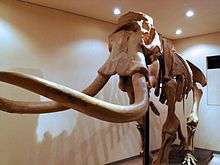Palaeoloxodon naumanni
| Palaeoloxodon naumanni | |
|---|---|
 | |
| Scientific classification | |
| Kingdom: | Animalia |
| Phylum: | Chordata |
| Class: | Mammalia |
| Order: | Proboscidea |
| Family: | Elephantidae |
| Genus: | †Palaeoloxodon |
| Species: | †P. naumanni |
| Binomial name | |
| Palaeoloxodon naumanni (Makiyama, 1924) | |
| Synonyms | |
| |
Palaeoloxodon naumanni, occasionally called Naumann's elephant,[1] is an extinct species belonging to the genus Palaeoloxodon that lived in Southern Japan in the late Pleistocene about 500,000 to 15,000 years ago. It is named after Heinrich Edmund Naumann who discovered the first fossils at Yokosuka, Kanagawa, Japan.
Description

Palaeoloxodon naumanni is closely related to the modern Asian Elephant, Elephas maximus. Similar to mammoths P. naumanni had a subcutaneous fat layer and long fur[2] as an adaption to a cold environment. The species had a pair of long twisted tusks and a bulge on the head.[2] These tusks grew more than 2.4 m in length, 20 cm in diameter.[3] It was a little smaller than Asian elephants averaging 2.5 metres (8.2 ft) to 3 metres (9.8 ft). It lived in forest which mixed subarctic conifers and cool-temperate deciduous trees.[4]
The ancestor of Palaeoloxodon naumanni moved from the Eurasian continent to Japan via a land bridge; it subsequently evolved independently and spread throughout Japan after the land bridge was covered by rising seawaters. Palaeoloxodon naumanni was hunted by the inhabitants of the time. Some fossils were found around Lake Nojiri in Nagano prefecture, together with many lithic and bone tool artifacts.[3]
Discovery and nomenclature
In 1860, the first fossil record was found at Yokosuka and the bottom of Seto Inland Sea, Japan. Heinrich Edmund Naumann researched and reported these fossils in “Ueber japanische Elephanten der Vorzeit” (1882). Naumann classified the fossil as Elephas namadicus Falconer & Cautley. In 1924, Jiro Makiyama researched fossils which were found in Hamamatsu, Shizuoka and reported the elephant was a new subspecies and deseignated the fossil Elephas namadicus naumannni in “Notes on a fossil elephant from Sahamma, Totomi” (1924). Tadao Kamei identified Elephas namadicus naumanni as a new species, called Palaeoloxodon naumanni, from fossils found at Lake Nojiri. It has also been called Elephas naumanni.[4]
References
- ↑ Norihisa, Inuzuka; Hasegawa, Yoshikazu; Nogariya, Hiroshi; Kamei, Tadao (31 Jan 1975). "On the Stylohyoid Bone of Naumann's Elephant (Elephas naumanni MAKIYAMA) from Lake Nojiri" (PDF). Memoirs of the Faculty of Science, Kyoto University. Series of geology and mineralogy. 41 (1): 49. Retrieved 2 March 2017.
- 1 2 Taga town Museum Archived 2012-02-29 at the Wayback Machine.
- 1 2 野尻湖と最終氷期の古環境
- 1 2 ナウマン象に出会った石器たち「-3万5千年前の石器製作跡か?-」 Archived 2011-07-22 at the Wayback Machine.
External links
| Wikimedia Commons has media related to Palaeoloxodon namadicus. |